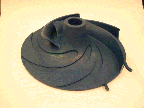Data: Wed 28 Nov 2001 - 11:27:17 MET
Message-ID: <000501c177f7$41473e20$051d9c95@iod.krakow.pl>
Content-Type: multipart/related; type="multipart/alternative"; boundary="----=_NextPart_000_0001_01C177FF.A2B7B9C0"
Brafe
December 2000
Brafe and the Repliwax® Solution
The Repliwax®* project was borne out of the recognition that near net shape technology is a must for European foundries wishing to find a niche in the casting market of the future. The objective was to develop a process which would reduce manufacturing costs and extend the weight range of investment castings. This has been achieved by enabling thinner ceramic shells to be used and these shells to be handled and poured at (or near) room temperature. The shorter processing time in shelling and improved logistics in melting and pouring is of special benefit to SME producers, such as Brafe Engineering Ltd.
Components produced using the Repliwax® facility at Brafe,
include an impeller for ABS in Sweden.
Download Full Article Here (High Res. Version)
Download Full Article Here (Low Res. Version)
If you require a printed version of this article, please email us at info@castingstechnology.com
Summary
The objective of the Repliwax® project was to develop a process which would reduce manufacturing costs and extend the weight range of investment castings. Trials and, more recently, commercial production at Brafe Engineering have proven that the process does indeed lower material costs, and it also allows faster and more flexible production and improvements in yield. As the process has been found to be suitable for larger castings, customers will, in future, be able to source products not currently available as an investment casting.
Ten European partners took part in the Brite Euram CRAFT research project, which began in May 1998 and concluded in April 2000. Brafe took the opportunity to become one of the two demonstration facilities, helping to promote European-wide best practice. Components produced by Brafe to date include a large impeller, for ABS in Sweden, and an HEF Bonnet and a V-Ball valve for Fisher Controls International Inc (see above).
In summary the following benefits have been demonstrated to date:
• Increased shelling capacity of up to 35%
• Reduced shell material usage of up to 50%
• Elimination of pre-heating costs
• No safety risks from handling hot and heavy shells
• Significant increases in pouring capacity (higher volume melts)
• Increased yield through larger numbers of castings per melt
• Increased weight range from grammes to 140Kg or more
• Elimination of metal run-out due to burst moulds
• Reduced distortion due to shell bulging
• Reduced certification costs per component
Benefits of casting cold thin ceramic shells
Using the Repliwax® process, wax patterns are assembled onto runners and shelled as in conventional investment casting. However, in this process, the shells are much thinner and they are cast at (or near) room temperature, i.e. without pre-heating, and supported in a sand bed.
The process allows a reduction in the number of coating layers and this has been shown to lower the ceramic material usage by up to 50%, giving a 35% increase in shelling capacity. For example, a large steel casting of 140kg cast weight was produced using an 8-coat shell, compared with 14-coats used in the investment process.
There are further direct savings through the elimination of pre-heating costs and there are no safety risks associated with the handling of hot shells. The arrangement of numerous shells in a casting box prior to pouring can allow a significant increase in pouring capacity with the utilisation of larger melts and a greater number of castings per melt and with the added benefit of reduced certification costs per component. Brafe Engineering has also been able to maximise the yield of every melt by pouring into 'off the shelf' moulds for future use. This flexibility is not always possible when the shells need to be pre-heated.
Andrew Dalby, Brafe's Technical Director, says "Our customers are gaining a huge benefit in being able to supply waxes from existing dies and receiving small batch production in high specification materials. It is even more pleasing that the turnaround on these jobs is often faster than with their usual commodity sourcing".
The Future
The research programme 'Lower Cost Investment Castings Produced in Thin, Cold Ceramic Shells' (Reference BRST-CT98-5223) officially ended in April 2000 but many of the partners are continuing to develop the process to meet their individual needs. In addition to the advantages of near net shape casting and improved surface finish, the process is also environmentally friendly when compared to standard investment casting, in terms of both material usage and energy costs.
Project Partners:
CDC, Brafe Engineering Ltd, Microcast SA, Pose-Marre Edelstahlwerk GmbH, CMS srl, Sabre Instrument Valves Ltd, Thyssen Umformtechnik + Gus GmbH, Titan Aluminium Feinguss GmbH, Zollern & Comandita, Hidrostal AG.
Companies wishing to find out more about the process or obtaining a Repliwax® licence should contact Dr Mike Ashton, Castings Technology International, 7 East Bank Road, Sheffield, S2 3PT, UK, Tel: +44 (0)114 2728647, Fax: +44 (0)114 2730852, e-mail: info@castingstechnology.com, internet: www.castingstechnology.com.
Companies requiring high quality castings in special materials should contact Andrew Dalby at Brafe Engineering.
Andrew Dalby, Brafe Engineering, Grundisburgh Rd, Woodbridge, Suffolk, IP13 6HX, UK. Tel: +44 (0)1394 380000 Fax: +44 (0)1394 380300 e-mail: info@brafe.com internet:www.brafe.com
*Repliwax® is a registered trade mark of Castings Technology International. The process is patented and may only be used in accordance with the terms and conditions of a CTI licence agreement.
Return to News Index / R&D / Home

- application/octet-stream za³±cznik: absimpeller.jpg

- application/octet-stream za³±cznik: impcoat272.jpg